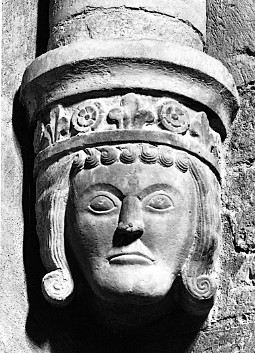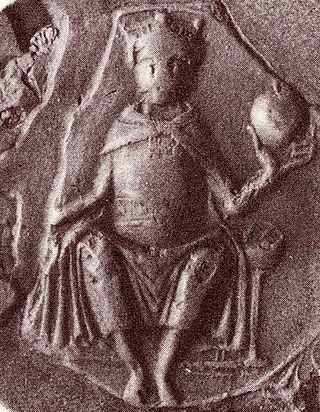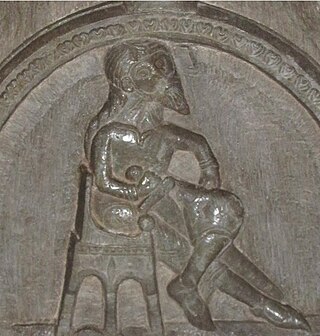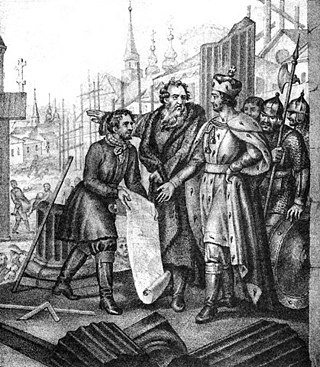
Birger Jarl, also known as Birger Magnusson, was a Swedish statesman, jarl, and a member of the House of Bjelbo, who played a pivotal role in the consolidation of Sweden. Birger also led the Second Swedish Crusade, which established Swedish rule in Finland. Additionally, he is traditionally attributed to have founded the Swedish capital, Stockholm, around 1250. Birger used the Latin title of Dux Sweorum, and the design of his coronet combined those used by continental European and English dukes.

Eric "XI" the Lisp and Lame Swedish: Erik Eriksson or Erik läspe och halte; Old Norse: Eiríkr Eiríksson was king of Sweden in 1222–29 and 1234–50. Being the last ruler of the House of Eric, he stood in the shadow of a succession of powerful Jarls, especially his brother-in-law Birger Jarl, whose descendants ruled as kings after his death.
John I was the king of Sweden from 1216 until his death.

Eric "X" was the King of Sweden between 1208 and 1216. Also known as Eric the Survivor, he was, at his accession to the throne, the only remaining son of King Canute I of Sweden and his queen. The name of his mother is not known, but may have been Cecilia.
Sverker II or Sverker the Younger was King of Sweden from 1195 or 1196 to 1208 when he was defeated in the Battle of Lena by Prince Eric. Sverker died in the 1210 Battle of Gestilren where his forces battled those of King Eric X.

Canute I was king of Sweden from 1173 to 1195. He was a son of King Eric the Saint and Queen Christina, who was a granddaughter of the Swedish king Inge the Elder.

Charles VII or Carl was ruler of Götaland, and then King of Sweden from c. 1161 to 1167, when he was assassinated in a military attack by Knut Eriksson who succeeded him as Canute I.

Sverker I or Sverker the Elder, murdered 25 December 1156, was King of Sweden from about 1132 till his death. Of non-royal descent, he founded the House of Sverker, the rulers of which alternated with the rival House of Eric over the next century.

The Battle of Gestilren took place on July 17, 1210. The battle was fought between the exiled King of Sweden Sverker and the ruling King Eric X. Sverker had been beaten in the previous Battle of Lena, but returned with new forces. Sverker was however killed in the battle. The exact strength of the armies is unknown.
Magnus Minniskiöld was a medieval Swedish magnate from the House of Bjelbo. For posterity, he is best known as the father of the renowned statesman Birger Jarl, and the ancestor of the later Swedish kings. He is sometimes believed to have perished in the Battle of Lena in 1208, though the evidence is not conclusive.

Kol was a Swedish prince who, together with his brother Burislev was a contender for the throne of Sweden from 1167 until his violent death a few years later. The struggle was a stage in the rivalry between the House of Sverker, to which Kol and Burislev belonged, and the House of Eric.
Boleslaw was a Swedish pretender for the throne, belonging to the House of Sverker. He acted in concert with his kinsman Kol against King Canute I of Sweden, then head of the House of Eric. The two pretenders, who were brothers, half-brothers, or uncle and nephew, may never have controlled much more than the Province of Östergötland, which was the base of the dynasty. Boleslaw is believed either to have been murdered by King Canute's men, or to have fled to Poland in or before 1173.
Magnus II; Swedish: Magnus Henriksson was a Danish lord and king of Sweden between 1160 and 1161. He is often seen by posterity as a usurper.
Swedish–Novgorodian Wars were a series of conflicts in the 12th and 13th centuries between the Republic of Novgorod and medieval Sweden over control of the Gulf of Finland, an area vital to the Hanseatic League and part of the Varangian-Byzantine trade route. The Swedish attacks against Orthodox Russians had religious overtones, but before the 14th century there is no knowledge of official crusade bulls issued by the pope.
Swedish jarls were powerful noblemen in Sweden. There usually was only one holder of the title at a time, second only to the King of Sweden.
Ulvhild Håkansdotter, , was twice Queen of Sweden and once Queen of Denmark through her successive marriages to Inge II of Sweden, Niels of Denmark, and Sverker I of Sweden. Ulvhild had an important role in the Nordic dynastic connections of her time, but the sources are insufficient on detailed circumstances. She is mentioned as a femme fatale of medieval Scandinavia, as well as a benefactor of the Catholic Church.

The Finnish–Novgorodian wars were a series of conflicts between Finnic tribes in eastern Fennoscandia and the Republic of Novgorod from the 11th or 12th century to the early 13th century.

The Treaty of Lödöse was a peace treaty between the Swedish king Eric XI and the Norwegian king Haakon IV. The treaty was negotiated between King Haakon and the Jarl of Sweden, Birger Magnusson, in the town of Lödöse, during the summer of 1249. The main purpose of the treaty was to prevent mutual hostility from escalating into war. Some factions of the Swedish nobility wanted to attack Norway in retribution for a raid by King Haakon, which had targeted Norwegian rebels in the Swedish province of Värmland 24 years earlier.
IngegerdBirgersdotter of Bjelbo was Queen of Sweden as the second wife of King Sverker II.

John, who died between 1150 and 1153, was the eldest son of King Sverker I of Sweden of Sweden and his queen Ulvhild Håkansdotter. He had a role in the outbreak of a war between Sweden and Denmark in the 1150s.









